
With proper placement and safe operation, elevated platforms play an important role on the fireground. The primary benefits of elevated platforms are their versatility, their ability to deliver large amounts of water, their use in performing multiple rescues and removals from numerous locations in a short time, and their reconnaissance capabilities at emergencies and fire scenes.
Generally, when properly supplied and fed, a master stream from an elevated platform can deliver approximately 1,000-2,000 gallons per minute (gpm); that is four to eight tons of water each minute. Firefighters operating in the bucket of an elevated platform have the advantage of a clear line of sight to their objective, especially when operating high above a burning structure. Barring overhead restrictions, you can position an elevated platform to direct its stream into windows of multiple floors (even at the street level).
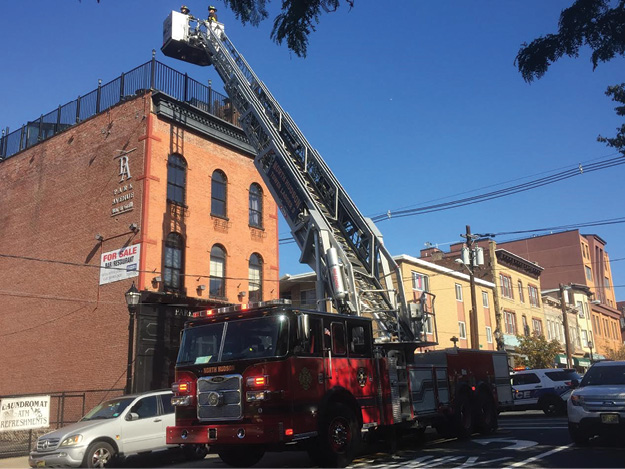
(1) Notice the side rails of this ladder tower. The aerial device is designed for safe climbing. The waterway is built into the underside of the aerial. (Photos by author unless otherwise noted.)
Not all elevated platforms are the same. In fact, many firefighters confuse the terms “tower ladder” and “ladder tower.” To be clear, a ladder tower (photo 1) is an aerial device with side rails designed for safe climbing and which is attached to a platform or bucket. By contrast, a tower ladder (photo 2) has aerial rungs and rails that resemble an extension ladder; it does not have the side rails found on a typical aerial ladder, and its rungs are there for emergency escape only. The waterways of either type of elevated platform may be enclosed or ride along the outside of the boom and escape ladder. Both types of elevated platforms vary in terms of load capacity, gpm, and master stream restrictions.
Regardless of the type of apparatus your department runs, it is important to ensure that all members are fully trained and prepared. For the purposes of this article, the term “tower ladder” will refer to both types of elevated platforms.
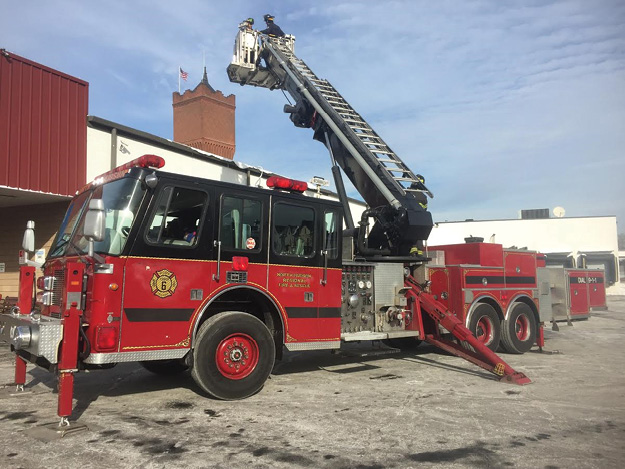
(2) Notice the ladder on this tower ladder. The ladder is there only for emergency escape. The waterway is visible along the left side of the boom.
The front of the building is the ideal placement for the first-due truck. If the tower ladder is the second-due truck, the incident commander (IC) may elect to keep the front of the fire building open for the tower ladder and position the first-arriving truck on another side of the building. For the most part, the fire conditions will determine the best placement of the tower ladder. Preincident planning and training will help identify locations in your response area where this type of alternate apparatus placement will be most beneficial.
Operational Guidelines
Following are some operational guidelines for performing tower ladder operations on the fireground:
Life hazard. The most important factor in all fireground operations is occupant life safety. Using the tower ladder to reach threatened victims will take priority over all else. Best practice is to position the turntable in line with the victim, which is required by aerial devices to ensure that the ladder is square to the objective. Conversely, when positioning a tower ladder to perform a rescue, position the bucket (and not the turntable) in line with the victim or window; this will reduce the time it takes to reach a victim and allow the side doors of the bucket to reach the objective first. If the tower ladder is positioned as a regular aerial device, the front of the bucket will reach the victim first and access will be hindered because of the nozzles and controls attached to the front of the platform.
If the bucket of the tower ladder has front opening doors, position the turntable in line with the victim for easier transfer into the bucket. Raise the bucket parallel to the structure, then rotate toward the objective. Use the bucket’s side doors to access the victim or window. Firefighters must be secured to the aerial using a safety belt or harness while assisting occupants into the bucket. Also, take precautions to ensure that the aerial isn’t moved during the rescue. Consider using the aerial’s “emergency stop” or “override” features to prevent accidental movement of the aerial.
The size and extent of the fire. Determining whether your placement will be for an offensive, a defensive, or a transitional operation may depend on the fire conditions on arrival. During initial offensive operations, position the tower ladder to obtain optimal scrub area (the surface area of a building that the bucket can reach) so you can efficiently conduct victim rescue, roof operations, vent-enter-search, and master stream operations.
A heavy body of fire in a one-story taxpayer or strip mall may require the tower ladder to position the bucket at the street level to direct its stream up into the cockloft or trusses in the ceiling for a quick “blitz attack.” A heavy body of fire venting from the roof that threatens taller exposures will necessitate that you position the bucket high above the structure and use its stream to prevent extension by directing the water stream onto the fire and then onto the exposure, alternating the stream from one to another.
For a well-involved top-floor fire, position the bucket to direct its stream into the ceiling of fire apartments to prevent extension into the cockloft or to knock down fire in the cockloft if the cockloft has already become involved.
The most likely avenue of fire progression. Consider the location of the main body of fire and where it will most likely want to go. Position the tower ladder to cut off fire well before it becomes too advanced to control. The last thing you want on the fireground is to be playing “catch-up.”
If the fire is in an attached structure located within a block, position it downwind, just past the involved structure; this will allow the tower ladder’s stream to extinguish the original fire and protect the downwind exposures. However, if you are met with a fully involved structure and both exposures are involved, take the front of the original fire building and operate the stream into all three structures.
In a large E-, I-, U-, or H-shaped multifamily tenement building (photo 3), position the turntable in line with the “throat” of the building; this will allow simultaneous coverage of separate wings and allow the tower ladder to try and cut off fire extension from one wing to another.
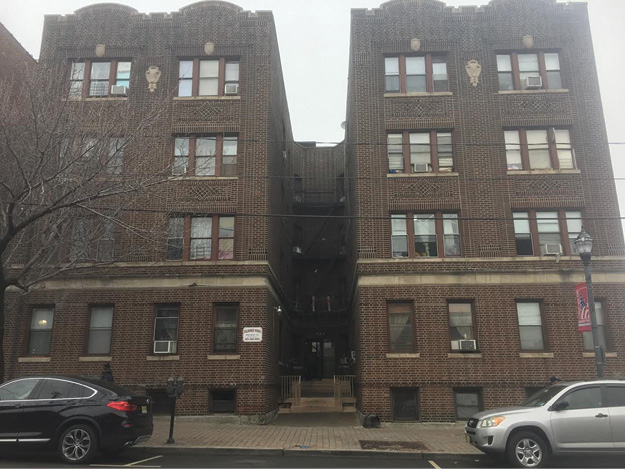
(3) Notice the throat (center) of this E-shaped building. Positioning the platform of the tower ladder in line with the throat will allow the bucket to cover multiple wings of the building.
In a fully involved lower-floor fire extending into upper floors, position the tower ladder far enough away from the structure to allow the bucket to be rotated, lowered, and extended toward the involved structure. Consider the nested length of the aerial as well as the distance needed to position the bucket to cover the lower floors.
Water supply. Delivering a productive master stream on the fireground takes disciplined coordination between the tower ladder operator and engine company pump operators. For large-scale operations, it may be beneficial for the IC to assign a water supply officer to coordinate the water supply dedicated to tower ladder master streams. Other considerations include the following:
• Ensure that engines assigned to feed the tower ladder have dedicated, continuous water supplies and that no other hoselines are being fed.
• It may be necessary for separate two-engine relays (four engines) to feed each of the tower ladder’s intakes with adequate pounds per square inch (psi). Ensure that each relay is connected to hydrants supplied by separate water mains. A city hydrant map will be useful in identifying suitable hydrants.
• Some tower ladders are fitted with an internal water tank and can pump supplied water to deliver the required gpm. Others are fitted with a waterway only and will provide a master stream only by being supplied by an engine company pumping water at the proper psi.
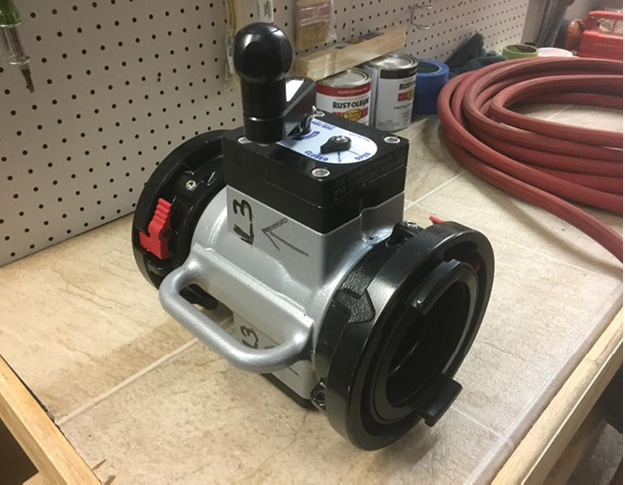
(4) The operator connects this inline valve when he sets up for master stream operations. One intake is supplied right away with a direct large-diameter hose (LDH) connection. Once additional water supplies become necessary, a second LDH can be connected to this valve.
• You cannot judge a good master stream by sight alone. Check the intake and discharge pressures as well as the gpm output by closely monitoring the appropriate gauges. The right combination of psi and gpm will be necessary to combat the British thermal units produced by a heavy body of fire.
• If the tower ladder has more than one intake, ensure that you can shut down each intake separately. If the intakes are part of an open waterway system, charging one intake will charge the entire waterway and prevent you from opening and supplying the second intake. It may be necessary to install special valves or adapters (photo 4).
• It is usually better to shut down the source than a valve at the base of the tower ladder to prevent a water hammer or broken valve handle because of the psi coming in. If you need to reposition the tower ladder quickly and shutting down the source will take too much time, carefully open and close affected valves to prevent or limit water hammer.
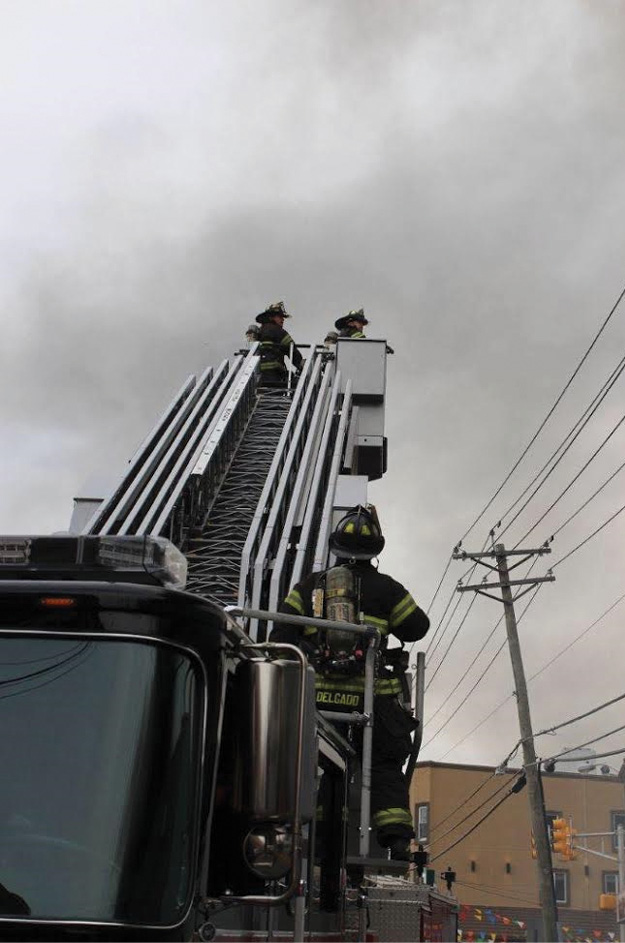
(5) The firefighter positioned at the turntable serves as a “lookout” for the firefighters operating in the bucket. This firefighter can override the controls from the turntable. (Photo by Ron Jeffers.)
General Safety Precautions
As in all fireground operations, safety is a priority. All members operating a tower ladder must be fully trained and have demonstrated their proficiency. All firefighters who will be operating the apparatus must read and understand the manufacturer’s operating and maintenance manuals thoroughly. Some other vitally important precautions all departments must demand from their crews include the following:
• All personnel operating on the aerial or in the bucket must wear a properly attached safety belt or harness.
• Never extend or retract the aerial with firefighters (or civilians) on the ladder, and secure all personnel safely in the bucket.
• Always position one firefighter at the turntable to serve as a “lookout” (photo 5). This firefighter will be able to see obstructions that may not be visible to the firefighters in the bucket. The firefighter at the turntable can override the controls of those operating from the bucket.
• Pay extremely close attention to overhead power lines. The aerial, equipment, and personnel must remain at least 10 feet away from energized power lines (photo 6).
• You must deploy stabilizing jacks and outriggers on firm, solid ground. Snow, ice, soil, or any unstable ground can cause the apparatus to shift.
• If it is necessary to short-jack the outriggers, operate the aerial only on the side that is fully extended and stabilized. (Refer to the manufacturer’s manual for limitations.)

(6) Always position at least 10 feet away from energized power lines. In this photo, it was confirmed with the power company that the lines were deenergized. (Photo by Ron Jeffers.)
• Always ensure that there are enough spotters in place as the stabilizers are being deployed. Stabilizers present a crush hazard.
• Ensure that the bucket does not contact a parapet when placing the bucket on a roof. If there is no parapet on the roof, place the bucket just touching the rooftop.
• Before lowering the bucket off the roof, raise the aerial to ensure that the bucket does not come into contact with any part of the roof while retracting.
• Never place any part of the tower ladder within possible collapse zones. This is especially true when operating the bucket from the street level.
• Always obtain confirmation that all interior firefighting forces and occupants have been removed before beginning master stream operations.
• Look out for collapse indicators, and establish collapse zones. A flow of 1,000 gpm delivers up to four tons of water per minute. The tower ladder officer MUST monitor water runoff out of the structure. If there is no visible water runoff, it may be filling up in the basement or stock within the building may be absorbing it, adding weight to the floors, thus creating a collapse hazard.
• Do not direct master streams at parapets. The force of the stream will knock down these free-standing walls.
• Always ensure that scheduled preventive maintenance is being conducted and documented.
A tower ladder is extremely valuable on the fireground. It is important to be familiar with its capabilities as well as its limitations. The load capacities of elevated platforms vary based on slope, angle, extension, gpm discharge, and even wind speed.
As is the case with everything else in the fire service, constant, quality training is the key to using the tower ladder to its fullest potential. All fire department members—not just those assigned to the tower ladder—should be trained in its operation.
RELATED
Transporting Portable Ladders with the Tower Ladder Bucket
TOWER LADDERS: POSITIONING TIPS AND TECHNIQUES
ALIDER PRATTS is a battalion chief with North Hudson (NJ) Regional Fire and Rescue. He is a also a New Jersey state-certified fire instructor and an instructor at the Monmouth County (NJ) Fire Academy.

